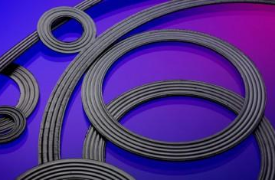The development of emission reduction in the US
In the last decades and up to this day, the developments regarding emission reduction continues. This has to do with the results of studies, the changes of gaskets materials and the upcoming importance of environmental health. ElastaGraph™ plays an important role in the development of emission reducing gaskets.
Gasket investigation

The first research regarding emission was an EPRI study in 1982. This study helped to improve packing and gaskets. This was done in response to asbestos being removed from the market. During that time, only less than half of the gaskets were asbestos free, while the concerns about asbestos and its health effects grew. The use of asbestos in compressed sheet gaskets was declined. Asbestos has been used in sheet gaskets because it is chemically inert, nearly indestructible and because it can be processed into fiber.
Substitutes for asbestos
With the disappearance of asbestos, substitutes for asbestos containing gaskets arose. Substitute fiber formulations include aramid, glass, graphite, cellulose and PTFE. At first, those substitutes were not as reliable as asbestos. This was the first sign that gaskets should be improved.
First leakage
Building on the research in the 1980s, president Bush proposed legislation in 1989 about three major threats to the nation's environment: acid rain, urban air pollution and toxic air emissions. Due to this new legislation, revisions were made to the Clean Air Act which made this law approach more workable. Among other things, the revised Clean Air Act made it possible to use advanced monitoring devices that could measure leakages of gaskets. This enabled manufacturers to fine-tune their products in order to improve emission reduction.
Reduction of VOC's
One of the most toxic compounds are Volatile Organic Compounds (VOCs). In reaction with nitrogen oxides they play a significant role in the grow of ground level ozone and fine parts in the atmosphere. VOCs are emitted from power plants, industrial activities and vehicles and create environmental hazards and health effects. The most important benefit of emission reduction is the reduction of VOCs. The chemical industry has the highest emission levels due to the processing of a broad range of hazardous chemicals. Therefore, emission reduction in this industry is most desirable.
The development of ElastaGraph™ gaskets
The current emission reduction standard in the US is <500 PPM, using the methods outlined in EPA-453/R-95-017 document. To meet that standard, ElastaGraph™ was developed specifically to solve fugitive emission and compliance problems. It also performs well in bolted joints that experience thermal cycling or limited initial bolt load. ElastaGraph™ is the most economical way of meeting low emission requirements. ElastaGraph™ is primarily used in the chemical industry in order to provide a solution to reduce fugitive emissions, but also to allow end users to consolidation inventory by eliminating the need for various PTFE or non-asbestos sheet products.
How ElastaGraph™ gaskets contribute to emission reduction
ElastaGraph™ gaskets are made by our proprietary Dynagraph process which infuses a seamless layer of flexible graphite with varying density and thickness over a corrugated metallic core. ElastaGraph™ utilizes a unique corrugated pattern which increases the depth of the groove and the pitch at the peak of the corrugation, and has a unique low density graphite inner step. This greatly improves the gasket’s sealability over traditional corrugated designs.
How ElastaGraph™ stand out
The ElastaGraph™ gasket has graphite that is molded into the corrugations versus traditional CMG gaskets that utilizes high density calendared graphite which is only applied to the surface of the corrugated substrate. ElastaGraph™ gasket graphite is molded using one of the highest grade inhibited graphite on the market (see our website for our HPLE graphite datasheet).
Before and after ElastaGraph™
Before the Clean Air Act, a flange was considered leaking if the leak rate was 10,000 PPM or greater. The Clean Air Act was revisioned due to new studies that showed evolving products that could provide a higher degree of sealabilty. ElastaGraph™ gaskets played an important role in this development. The ElastaGraph™ was tested in accordance with numerous industry standards such as PVRC-ROTT, EN13555, etc. The results showed that the ElastaGraph™ has one of the lowest sealabilty factors in the industry.
Need more information about emission reduction and ElastaGraph™?
Leader Gasket develops and delivers all the gaskets you need worldwide. Need more information about our goals and our products? Feel free to contact us by filling in the form on the right.

